 The popular magazine, New Jersey Monthly, ranks the state’s public high schools every other year. Hawthorne High School was ranked 171 in 2010 but dropped to 234 out of 328 high schools in the state for the 2012 school year. Many students and parents are concerned by this drop. An examination of the data used to create the rankings helps explain what happened.
The popular magazine, New Jersey Monthly, ranks the state’s public high schools every other year. Hawthorne High School was ranked 171 in 2010 but dropped to 234 out of 328 high schools in the state for the 2012 school year. Many students and parents are concerned by this drop. An examination of the data used to create the rankings helps explain what happened.
“My initial reaction to Hawthorne’s ranking in New Jersey Monthly was one of surprise, disappointment, and lack of understanding,” said HHS principal Barry Cohen. Dropping 63 spots in the rankings is displeasing. How could this have happened in only two years? When analyzing the statistics for each school, to many in Hawthorne, the change did not make sense.
For example, 13 school districts that are ranked higher than HHS are on the state’s list of failing high schools. Hawthorne is not a failing high school; in fact, only one Hawthorne senior did not receive a diploma in 2012. HHS’s average SAT score is 1516—a score that is up 28 points over the prior year. Based on SAT scores, our school ranks a high 123 out of 328 high schools statewide. The standardized High School Proficiency Assessment scores in Hawthorne were 85.7 percent in Math and 100 percent in Language Arts (excluding special education students) in 2011. These statistics place Hawthorne in good company with high-achieving schools.
However, the factors that moved Hawthorne lower in the ratings include class size, faculty without advanced degrees, and limited electives and advanced placement courses. Hawthorne High School’s average class size is 23.8 students; its student-faculty ratio is 11.4. (This does not compare well with other schools, but it can also be viewed as showing that Hawthorne is, in fact, doing more with less.) In the past few years, quite a few teachers have retired, bringing in new teachers without advanced degrees. Still, 45 percent of Hawthorne High School teachers have either masters or doctoral degrees.
Cohen also explained that the number of course offerings and advanced classes is a budget and scheduling issue. For a comparative example, consider that the Hawthorne Public School District has an operating budget of $38 million, while Glen Rock High School, which is similar in size to HHS (and ranked fourth in the New Jersey Monthly rankings), spends $10 million more a year on education.
Also affecting the district’s school budget is that fact that Hawthorne is known for its excellent special education program, which brings families whose children have special needs into the town. This causes Hawthorne’s special education population to be significantly higher (at 25 percent of the student population) than the state average (12 percent). The cost to educate a special education student is much higher than the cost to educate a general education student. This drains the district’s budget significantly.
“We are interested in improving—not for the benefit of a New Jersey Monthly ranking—but for the benefit of our students in preparing them for their future,” said Cohen. One of the school’s improvement plans includes increasing the number of course offerings. Plans have been in the works for the last two-and-a-half years to increase HHS’s graduation requirements from 120 credits to 140 credits by moving from a traditional eight-period daily schedule to a modified drop schedule. In this type of schedule, students would take eight classes, instead of the present seven. Only six of the eight classes would meet on any given day in a rotating four-day cycle. There would be a common lunch period, instead of four lunches. Instructional time in each class would increase from 46 minutes to 55 minutes. “I believe that this type of schedule would better prepare students for college and career in the 21st Century,” stated Cohen, “through the addition of more electives and course offerings.”
New Jersey Monthly’s data used to rank schools comes directly from the New Jersey Department of Education but not everything that is important to education is taken into consideration. Technology, for example, is not considered. Hawthorne has recently added 120 new computers in three new computer labs. The high school now has more than 35 Promethean Boards throughout the school in classrooms to help Hawthorne students and teachers keep up with advances in technology.
In many ways, Hawthorne High School is growing, improving and working hard to give the students of Hawthorne the solid education they need to become educated citizens and tomorrow’s leaders. Regardless of magazine ranking scores, Hawthorne students continue to work hard, go on to excellent colleges and work programs, and make the school and the town proud of their accomplishments.
